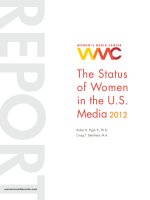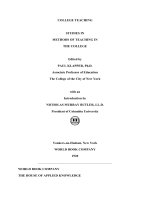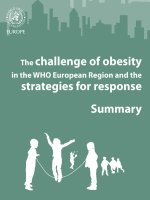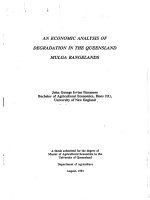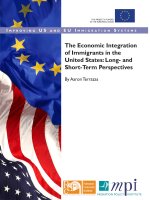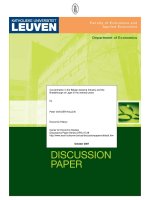Diversity and abundance of Dinoflagellates in the inshore waters and kali estuary off Karwar
Bạn đang xem bản rút gọn của tài liệu. Xem và tải ngay bản đầy đủ của tài liệu tại đây (335.2 KB, 8 trang )
Int.J.Curr.Microbiol.App.Sci (2019) 8(2): 3467-3474
International Journal of Current Microbiology and Applied Sciences
ISSN: 2319-7706 Volume 8 Number 2 (2019)
Journal homepage:
Original Research Article
/>
Diversity and Abundance of Dinoflagellates in the Inshore Waters
and Kali Estuary off Karwar
Swapnil Powar*, Shivakumar Haragi and Raveendra Durgekar
Department of Marine Biology, Karnataka University, Karwar, India
*Corresponding author
ABSTRACT
Keywords
Phytoplankton
biomass,
Dinoflagellates,
vegetative stage,
taxonomic groups
Article Info
Accepted:
20January 2019
Available Online:
10 February 2019
The diversity and abundance of dinoflagellates in the inshore waters off
Karwar and Kali estuary was studied for a period of thirteen months (Dec
14 to Dec 15). Thirty two species of dinoflagellates were recorded during
the study of which thrifty one species of dinoflagellates were recorded in
the inshore waters off Karwar and twenty eight species of dinoflagellates
were recorded in Kali estuary which joins the Arabian sea. Ceratium was
dominant genera in both inshore waters and Kali estuary.
Introduction
Accounting for approximately one-fourth of
all plants in the world (Jeffery and Vesk,
1997), marine phytoplankton are important
contributors to global carbon fluxes
(Falkowski et al., 1998). Phytoplankton
communities in the ocean comprise many
different taxonomic groups, which together
determine primary production and various
tropic level interactions. Quantification of
phytoplankton biomass and community
composition is important for understanding
the structure and dynamics of marine
ecosystems. Dinoflagellates are mainly
marine, unicellular bi flagellate algae. They
are characterized by a simple life cycle e and
which involves a vegetative stage and
encysted stage. They are generally spherical to
ellipsoidal or elongate, ranging in size from 25
microns to 250 microns. Dinoflagellates form
one of the major components of the
phytoplankton that form the base of the
aquatic food chain (Sournia, 1986; Dodge,
1987; Balech, 1988; Hallegraeff and Lucas,
1988; Horner, 2002; Polat and Koray, 2002;
Hernández-Becerril et al., 2008) and are
second in importance only to the diatoms
(Hernández-Becerril, 1988; Pulat and Özel,
2003; Licea et al., 2004; Balkis, 2005). In
3467
Int.J.Curr.Microbiol.App.Sci (2019) 8(2): 3467-3474
recent past a good amount of work on
phytoplankton on estuary as well as inshore
waters of Karnataka Coast were carried out
but there is no studies have been made on
dinoflagellates in Karnataka coast in general
and Karwar waters is particular. As Karwar
water is rich in its fishery resources, the study
of this dinoflagellates community is very
essential, which explains the status of the
water quality and productivity of a given area.
Hence, in the present study, a detailed work on
dinoflagellates will be carried out along with
environmental conditions which will certainly
give a better picture of productivity and nature
of the biotopes in and around Karwar region.
estuary for a period of 13 months. The data
was further studied seasonally with Monsoon
(June to September), Post monsoon (October
to January) and Premonsoon from (February
to May). Five stations were taken in the
inshore waters off Karwar and three station in
the Kali estuary, During the study a period a
total of 32 species of dinoflagellates were
recorded both in Inshore water off Karwar and
Kali estuary. Of the 32 species of
dinoflagellates recorded 31 species of
Dinoflagellates were recorded from the
inshore water during the study period and 28
species of Dinoflagellates were recorded from
the Kali estuary during the study period.
Materials and Methods
In station 1 (Majali) 29 species of
dinoflagellates were recorded in station 2
(Kurumgad) also 29 species of dinoflagellates
were recorded 28 species of dinoflagellates
were recorded in station 3 (Devagad), in
station 4 (Baithkol) 26 species of
dinoflagellates were recorded and in station 5
(Binaga) 24 species of Dinoflagellates were
recorded, all these stations were in the inshore
water of Karwar. In Kali estuary three stations
were selected in Station 6 (Kodibag) 24
species of Dinoflagellates were recorded and
in Station 7 (Kadwad) 23 species of
Dinoflagellates were found and in station 8
(Kanasgeri) 24 species of Dinoflagellates were
recorded (Fig 2).
Dinoflagellates analysis of Kali Estuary and
inshore waters of Karwar, west coast of India
was carried out on monthly basis from
December 2014 to December 2015 for a
period of 13 months. Five study sites were
selected in the inshore waters off Karwar.
Three study sites were selected in the estuary
of river Kali. Dinoflagellates were collected
from both the different biotopes. Analysis of
Dinoflagellates for abundance and distribution
at different selected stations. The results of
Dinoflagellates where further anlaysed using
PRIMER software.
Qualitative analysis of Dinoflagellates was
made based on the standard methods.
Phytoplankton Samples were collected in 1
liter plastic can of water from surface and then
it filtered with mesh size of 10µ. Later it was
preserved in 4% Lugol’s solution, then filtered
50ml of plankton sample and quantified by
using Sedgwick Plankton counting chamber
and identified by referring standard manuals.
Results and Discussion
The study was conducted in the inshore water
off Karwar and the estuarine region of Kali
During Monsoon season the dinoflagellates
varied from 14 nos in station 8 to a maximum
number of dinoflagellates were recorded in
station 1 and station 3 with 29 species, the
species were more in inshore waters compared
to estuarine region (Fig 3).
During
Pre
monsoon
season
the
dinoflagellates varied from 19 nos in station 8
to a maximum number of dinoflagellates were
recorded in station 1 with 27 species, the
species were more in inshore waters compared
to estuarine region (Fig 4).
3468
Int.J.Curr.Microbiol.App.Sci (2019) 8(2): 3467-3474
Table.1 Presence absence data of Dinoflageletes in inshore waters off Karwar and Kali estuary
Sl.No
1
2
3
4
5
6
7
8
9
10
11
12
13
14
15
16
17
18
19
20
21
22
23
24
25
26
27
28
29
30
31
32
Species
Ceratium furca
Ceratium lineatum
Ceratium fuscuc
Ceratium tripose
Ceratium minutm
Ceratium macrocerous
Ceratium lunula
Ceratium hexicntum
Prorocentrum micans
Prorocentrum gracile
Prorocemtrum
sigmodiesntr
Prorocentrum rostratum
Prororocentrum lima
Prorocentrum balticum
Prorocentrum sp.
Protoperidinium steinii
Protoperidinium
oceancicum
Protoperidinium bipes
Properidnium brevipes
Photoperidinium
depressum
Alexandrium miuntum
Alexandrium sp,
Gonyaulux spinifera
Gonyoulax digitalies
Dinophysis tripos
Dinsphyis miles
Dinophysis fortii
Dinophyszis mitra
Dinohysis sp,
Ornithocercus sp
Dynophysis caudata
Pyrocystis sp.
Stn 1 Stn 2 Stn 3 Stn4 Stn 5 Stn 6 Stn 7 Stn 8
+
+
+
+
+
+
+
+
+
+
+
+
+
+
+
+
+
+
+
+
+
+
+
+
+
+
+
+
+
+
+
+
+
+
+
+
+
+
+
+
+
+
+
+
+
+
+
+
+
+
+
+
+
+
+
+
+
+
+
+
+
+
+
+
+
+
+
+
+
+
+
+
+
+
+
+
+
+
+
+
+
+
+
+
+
+
+
+
+
+
+
+
+
+
+
+
+
+
+
+
+
+
+
+
+
+
+
+
+
+
+
+
+
+
+
-
+
+
+
+
+
-
+
+
+
+
+
+
+
-
+
+
+
+
+
+
+
+
+
+
+
+
+
+
+
+
+
+
+
+
+
+
+
+
+
+
+
+
+
+
+
+
+
+
+
+
+
+
+
+
+
+
+
+
+
+
+
+
+
+
+
+
+
+
+
+
+
+
+
-
+
+
+
+
+
+
+
-
+
+
+
+
+
+
+
-
+
+
+
+
+
+
+
-
3469
Int.J.Curr.Microbiol.App.Sci (2019) 8(2): 3467-3474
Table.2 Variation in Dinoflagellate diversity and species richness of Dinoflagellates
Individuals
Simpson_1-D
Shannon_H
Evenness_e^H/S
Margalef
Stn 1
29
1.67
2.72
1
3.46
Stn 2
29
1.66
2.8
1
3.46
Stn 3
28
1.62
2.7
0.99
3.47
Stn4
26
1.57
2.6
0.95
3.47
Stn 5
24
1.54
2.54
1
3.48
Stn 6
24
1.54
2.54
0.96
3.49
Stn 7
23
1.36
2.42
0.92
3.5
Stn 8
24
1.32
2.39
0.91
3.21
Fig.1 Locations of the study sites in the Kali estuary and inshore waters (Arabian Sea) of
Karwar
Fig.2 Total of Dinoflagellates recorded at different study stations
3470
Int.J.Curr.Microbiol.App.Sci (2019) 8(2): 3467-3474
Fig.3 Total no of dinoflagellates recorded at different study station during Monsoon
Fig.4 Total no of dinoflagellates recorded at different study stations during Pre monsoon
Fig.5 Total no of dinoflagellates recorded at different study stations during Post monsoon
3471
Int.J.Curr.Microbiol.App.Sci (2019) 8(2): 3467-3474
Fig.6 Dendrogram showing cluster analysis of Dinoflagellates at different seasons
During
Post
monsoon
season
the
dinoflagellates varied from 19 nos in station 8
to a maximum number of dinoflagellates were
recorded in station 1 with 26 species, the
species were more in inshore waters compared
to estuarine region (Fig 5).
The data analysis in Margalef’s species
richness (d’), Shannon- Weiner diversity
function (H’) and Pielou’s evenness (J’) was
used to reflect the underlying changes in
zooplankton species. The species richness and
diversity of zooplankton at six sampling
stations were determined using Pielous
evenness which was highest at the Stations 1,2
and 5 and lowest at the station 8. Margalef ’s
diversity was highest at the stations 6 (3.49)
and lowest at the station-4 (4.03). Shanon
indices was highest at the stations 1 (2.72) and
lowest at the station 8 (2.39) (Table 2). The
dendrogram revealed that the species
similarity were between the Pre monsoon and
Post monsoon was linked to Monsoon (Fig 6).
Same was seen and revealed in MDS plot with
station 1-4 clustering together and 5 and 6
away from the rest (Fig 4).
During the present which was conducted in
the inshore waters off Karwar and the Kali
estuary which joins the Arabian sea in west
coast of India. Totally eight study station were
recorded in the study area of which five
station in the inshore waters and three stations
in the Kali estuary. Generally the difference
between the stations was around 3 km in the
inshore waters and 2 km in the estuarine area.
Phytoplankton’s were collected as per the
standard procedure and dinoflagellates were
identified. During the study a total of 32
dinoflagellates were recorded of which 31
species of Dinoflagellates were identified in
the inshore waters and 28 species of
dinoflagellates in the estuarine area. Seeing
this more diversity of Dinoflagellates were
recorded in the inshore waters. Maximum
dinoflagellates were recorded in the Station 1
and Station 2 which is around 5 km from the
bar mouth of river Kali. Seasonal study of
dinoflagellates were studied and it was seen
that the maximum diversity of dinoflagellates
was recorded during Pre monsoon both in
Inshore water as well as estuary followed by
Post monsoon and least diversity was
observed during the monsoon in both inshore
waters as well as estuary, Little work on
exculisely on dinoflaggelates in west coast of
India is very limited. Mirudla et al., (2002)
studied on the diversity of dinoflagellates in
3472
Int.J.Curr.Microbiol.App.Sci (2019) 8(2): 3467-3474
the sea off Mangalore and recorded 13 species
of dinoflagellates. Ceratium was the dominant
dinoflagellates in Karwar waters which
consisted of eight species of dinoflagellates.
Several workers have recorded the occurrence
of Ceratium as the dominant dinoflagellates
tthat occurred regularly (Devassy and Goes,
1988, Lingdhal et al., 1988) Devasssy and
Goes 1989 recorded appreciable number of
Ceratium and Peridinium in the waters of
Laccadives respectably. Reverse to all these
studies poor dinoflagellates were recorded by
Nair and Achuthankutty (1980) along the west
coast of India, Jiyalal Ram et al., (1984) also
observed abundance of dinoflagellates during
post monsoon season in the coastal waters of
Mangalore and Thal region. During the
present study, Dinoflagellates were recorded
in large numbers both in inshore waters and
estuarine region.
Further intensive and long term studies are
required
to
evaluate
the
secondary
productivity of the estuary on a seasonal,
annual basis and also elucidate the plankton
biodiversity in the estuary.
References
Balech, 1988: Los dinoflagelados del
Atlantico Sudoccidental. Publicaciones
especiales del Instituto Español
Oceanografia, 1:1-310.
Balkis, 2005: Contributions to the knowledge
of marine phytoplankton of Turkey.
Pakistan Journal of Botany, 37: 807814.
Devassy, V.P., Goes, J. I., 1988.Phytoplankton
community structure and succession in
a tropical estuarine complex central
west coast of India. Estuarine, Coastal
and Shelf Science 27, 671–685.
Devassy V P and Goes J I 1989 Seasonal
patterns of phytoplankton biomass and
productivity in a tropical estuarine
complex (west coast of India); Proc.
Indian Acad. Sci. (Plant Sci.) 99 485–
501.
Dodge, 1987: A hypothecal pore in some
species
of
Protoperidinium
(Dinophyceae). British Phycological
Journal, 22: 335-338.
Falkowski, P. G., Barber, R.T., Smetacek, V.,
1998. Biogeochemical controls and
feedback on ocean primary production.
Science 281, 340-343.
Hallegraeff, G.M. and Lucas, I.A.N. 1988.
The marine dinoflagellate genus
Dinophysis
(Dinophyceae):
photosynthetic, neritic and nonphotosynthetic,
oceanic
species.
Phycologia,
27:
25-42.
doi:
10.2216/i0031-8884-27-1-25.1
Hernández-Becerril, D.U., Ceballos-Corona,
J.G.A., Esqueda-Lara, K., TovarSalazar, M.A. and León-Alvarez, D.
2008.
Marine
planktonic
dinoflagellates
of
the
order
Dinophysiales (Dinophyta) from coasts
of the tropical Mexican Pacific,
including two new species of the genus
Amphisolenia. Journal of Marine
Biological Association of the United
Kingdom,
88:
1-15.
doi:10.1017/S0025315408000143.
Horner, R. 2002. A taxonomic Guide to some
Common Marine Phytoplankton. Bio
Press Bristol UK. 195 pp.
Jiyalal Ram, M., B.N.Desai and S.A.H. Abidi
1984.
Diurnal
variation
of
phytoplankton
pigments
and
population in the near inshore waters
of Thal (Maharastra), Mahasagar,
17(1): 171-1980.
Jeffery, S.W., Vesk, M., 1997. Introduction to
marine phytoplankton and their
pigment signatures. In: Jeffery, S.W.,
Mantoura, F.C., Wright, S.W., (Eds.),
Phytoplankton
Pigments
in
Oceanography. UNESCO Publishing,
Paris, pp. 85–126.
3473
Int.J.Curr.Microbiol.App.Sci (2019) 8(2): 3467-3474
Licea, S., Zamudio, M.E., Luna, R. and Soto,
J. 2004. Free-living dinoflagellates in
the Southern Gulf of Mexico.
Phycological Research, 52:419-428.
doi: 10.1111/j.1440-183.2004.00364.
Lingdhal, C., T.R.C. Gupta, A.M. Ramesh and
G. Gowda. 1998. Phytoplankton
distribution in the vicinity of KIOCL
discharge pipeline in the Arabian sea
of Mangalore. Indian Journal of
environment science. 2(2) 131-135.
Mirudla et al., 2002. Diversity of
Dinoflagelates in the sea off
Mangalore, Indian journal of Fisheries.
49(1) -48-50.
Nair and C.T. Achuntakutty 1980. Plankton
composition waters between Jaigarh
and Rajapur along west coast of India.
Mahasagar, 13 (4):343-352.
Polat, S. and Koray, T. 2002. New records of
the genus Histioneis F. R. von Stein
(Dinophyceae) from Turkish coastal
waters. Turkish Journal of Botany, 26:
481-484.
Pulat, I. and Özel, İ. 2003. The plankton fauna
of the nortnern lagoonary system of
Izmir Bay. Ege University. Journal of
Fisheries and Aquatic Sciences, 20:
399-403.
Sournia, A. 1986. Atlas du Phytoplancton
Marin. Introduction, Cyanophycees,
Dictyochophycees, Dinophycees et
Raphidophycees. 1. Centre National de
la Recherche Scientifique, Paris.
How to cite this article:
Swapnil Powar, Shivakumar Haragi and Raveendra Durgekar. 2019. Diversity and Abundance
of Dinoflagellates in the Inshore Waters and Kali Estuary off Karwar.
Int.J.Curr.Microbiol.App.Sci. 8(02): 3467-3474. doi: />
3474
